
Engage with targeted UPSC Geography Optional Mains Topic Wise Questions centered on Environmental Geography. Dive into the multidisciplinary field examining the interplay between human activities and the environment, crucial for UPSC mains preparation. Each question is meticulously tailored to deepen comprehension and analytical skills, covering a diverse range of environmental concepts and their implications. From ecosystem dynamics to sustainable development, aspirants gain valuable insights into the complexities of environmental challenges and solutions. With detailed explanations and structured content, this resource serves as an essential tool for mastering environmental geography principles, vital for success in the UPSC examination. Whether you’re a newcomer or seasoned aspirant, immerse yourself in Environmental Geography to elevate your UPSC Geography Optional Mains preparation and excel in your examination endeavors.
Contents
- 1 Q1. Define ecosystem and describe briefly its various components. Also discuss how and to what extent the modern man has affected the various types of ecosystems. (1993)
- 2 Q2. Discuss the global ecological imbalance and their management? (2006)
- 3 Q3. Bring out the major problems of environmental pollution at global scale and suggest measures to check it. (2005)
- 4 Q4. How would the impact of global warming differ from one part of the earth to another? Give a reasoned account. (2004)
- 5 Q5. Write an essay on ‘sustainable development’ from the perspective of geography. (2002)
- 6 Q6. Discuss the causes and consequences of environmental degradation and highlight the related conservation measures. (2000)
- 7 Q7. Discuss the relevance of watershed as an ecosystem for the purpose of sustainable Development. (1999)
- 8 In case you still have your doubts, contact us on 9811333901.
Q1. Define ecosystem and describe briefly its various components. Also discuss how and to what extent the modern man has affected the various types of ecosystems. (1993)
Answer:
The relationship between biotic community (living) and abiotic environment (physical) or among the members of the biotic community themselves are known as ECOSYSTEM. The living community includes “autotrophs” (producer), “heterotrophs” (consumer) and “saprotrophs” (decomposer).
Abiotic components include all non-living materials in the surrounding environment like water, Carbon-dioxide, Oxygen, Phosphorus, etc. Biotic components include all of the living organisms and are mainly of two types : Autotrophic and Heterotrophic. Autotrophic components are also called producers or convertors because they have the capacity to fix light energy into chemical energy. Heterotrophic components are also called consumers. They consume the matter built by the producers. Again the heterotrophic components are of two types : Macro Consumers and Micro Consumers. Macro Consumers include : (1) Herbivores, who feed on autotrophs, (2) Omnivores, who feed on both autotrophs as well as herbivores and (3) Carnivores, who feed on herbivores. Micro Consumers are also known as “decomposers”. They include chiefly bacteria, actinomycetes and fungi. They feed on dead materials, so called “Saprotrophs”. They breakdown complex compounds or dead or living protoplasm into smaller inorganic nutrients, making them again available to autotrophs.
Abiotic substance supply nutrients to the autotrophic plants. The latter produces organic compounds from these nutrients and sunlight, through the process of “photosynthesis”. Heterotrophs are unable to synthesize food and hence, they depend upon plants directly or indirectly for their food. The wastes and the dead bodies of plants and animals are acted upon by the decomposers and are converted into simple organic and inorganic substances and are returned into soils.
Natural ecological grouping of plants and animals & the associated environment are called “BIOMES”. Biomes may be very small such as laboratory culture or very large like sea or desert. Major ecosystem of the world can be broadly divided into (1) Marine-Sea, Shore and Estuaries (2) Fresh water-Streams & Rivers, Pond & Lakes, Marshes & Swamps. Terresterial Biomes include (1) Forest-Tropical, Temperate & Taiga (2) Grassland-Tropical & Temperate (3) Tundra and (4) Desert.
Inter-Relation of Energy flow : All Ecosystems take energy in one form or another in order to convert it into organic material and to given up waste materials. As a result, there are two basic types of linksor flows between the component parts of all ecosystems, namely:
I. Energy flow, and
II. Biological Cycling
Energy flow is a dynamic function of all ecosystems. It is inter-related among various components of the system. Energy can be defined simply as the ability to do work. All organisms need a source of energy to live. The organic components of the ecosystem are very intimately linked to one another by a mutual interdependence on food energy. The initial source of all but a minute fraction of the energy is the sun. The light energy flows everlasting from solar to the earth system. Light energy is the means whereby plant materials wich have chlorophyll in their cells can build up complex organic substances, such as carbohydrates from simpler inorganic substances such as carbon, oxygen and hydrogen. This process is known as photosynthesis or primary Biological Productivity. The given equation summarises it.

Food Chains : Energy fixed in net primary productivity is consumed by animals, who are unable to manufacture their own food. The fixed energy is first consumed by harbivores (primary consumer) and then by carnivores (secondary consumer) and eventually by predators or top carnivores (tertiary consumers). The remains of plants and animals tissue are eventually consumed by decomposing organisms e.g., bacteria and fungi.
Solar energy is introduced in the biosphere through photosynthesis. Only about 1% of the energy received from the sun by the earth is fixed through photosynthesis. The flow of energy can be studied into two ways :-
(1) Food relationship between species and the community by way of food chain, food web and tropic levels.
Food chain represents single energy pathway. For example, the grass eaten by deers which in turn is eaten by lions. In land communities with large herbivores, food chains are usually short and have two or three links, but large in the case of marine and fresh water. Numerous food chains exist in a community. Many of these chains are interconnected by species which exist in more than one chain. These interconnected food chains constitute a “Food Web”.
If we compare the number of organisms living at each trophic level in a chain, then we can represent the chain by a “Pyramid”.
(2) To assess the energy flow in terms of number of organisms, their biomass and organic contents.
In the process of eating and being eaten, energy flows through the ecosystem, passing from one trophic level to the next. However, food chains do not normally have more than five or six levels. This is because, the process of energy transfer is not very efficient. On an average, about 90% energy is lost as heat and discarded as feaces to the surrounding environment at each trophic exchange. In other words, only about 10% of the energy at one trophic level is subsequently fixed in the tissues of the succeeding level.
LINDEMANN, in 1945, gave a most useful generalisation which is called “10% LAW”. This law states that in nature only some fraction of energy entering any population is available for transfer to the next population that feed upon the former. The actual amount varies. In grazing chain, for example, 100 kg of organic-matter in grass will turn into 10 kg of flesh of a deer, which in turn will form 1 kg of flesh of lion that feed on the deer.
Q2. Discuss the global ecological imbalance and their management? (2006)
Answer:
The global ecological imbalance has emerged as a major global concern for human survival. Modernization is steadily transforming the nature into products. The resource squeeze has led to an ever-intensification of ecological damage. Land, water and air are being polluted every time. Deforestation is proceeding at an alarming rate depleting the genetic store.
Mega technology has created problems of waste disposal and industrial revolution has now become a great hazard to the environment as well as to humanity.
Man’s enviornment by now is sufficiently saturated by complex chemical emissions, aerosols, toxic effluents, sewage, pesticides, solid wastes, polluted rains, dust and radiation. Ecological imbalance is the most challenging problem not only of developing countries but also of the developed world.
Nature and type of Ecological imbalance: The environment is an integrated system in which all its elements act and react in such a way that a balance is always maintained. Scientific and technological development has given several benefits to mankind but at the same time, it is also responsible for various types of environmental imbalances such as:
Enviornment Imbalance due to Soil Erosion: Large scale soil erosion leads to the degradation of the environment. It may be a natural process or man-induced also. The main types of soil erosion are as follows:
- Normal or natural erosion.
- Fluvial erosion.
- Wind erosion.
- Marine erosion.
- Soil erosion by human actions.
Normally soil erosion is a continuous process and its impact on environment is also limited, but when it occurs on large scale due to water and wind erosion, it not only degrades the environment but is also responsible for the expansion of waste land due to gullies and ravines.
The process of soil erosion is always accelerated by man either by overgrazing, faulty land practices or by deforestation. The slow downslope movement of soil and regolith is known as soil creep.
The impact of soil erosion on the environment is both local as well as regional. Infact, too much soil erosion is one of the causes of imbalance. In India, the problem of soil erosion can be seen in Jammu & Kashmir, Himachal Pradesh, U.P, Bihar, Assam, Arunachal Pradesh, Sikkim as well as in areas of Rajasthan and M.P. It has been estimated that in India about 53 percent of the area is suffering from the problem of soil erosion. Indian rivers carry about 600 million tons of soil every year.
Environmental Degradation by Volcanoes and Earthquakes: A volcanic explosion poses a great threat to the environment. A volcanic explosion ejects 150 cubic km of material. The eruptions of valcanoes and lava flows are environmental hazards of the severest type, often taking a heavy toll on plant and animal life.
The earthquake belt of the world is also associated with the volcanic belt, but several other regions too have occurrence of earthquake. Earthquakes cause, apart from loss of life and property, landslides which change the course of rivers and also results in loss of vegetation and animal life.
Flood, Droughts and Famines: Flood is a hydrological phenomenon that occurs in any drainage basin. The devastating effects of flood can be seen on vegetation, agriculture, industry, settlements, sometimes causing loss of human and animal lives and of
materials also.
The main cause of flood is excessive rainfall but occurs due to earthquakes, deforestation in the upper catchment area, failure of dams, excessive snow melting etc also.
Drought is also a natural hazard which has its impact on the regional ecosystem. The areas which get less rainfall and have amount of rain which is too less to support agriculture protection or even grassland are called drought-prone areas.
Famines: Drought occures when rainfalll is less than 25 to 50 percent of the long term average. If it is below 50 per cent of the average, the situations is called famine.
Desertification: A systematic phenomenon involving deterioration of the ecosystem due to change in the pressure of human adapation. It is a process through which fertile or non-desertic land is converted into dry, infertile or desertic land.
Ecological Imbalance due to Deforestation: As the population increased, more forests were cleared for various uses. Additionally, the commercial exploitation of forests is the main cause of deforestation. In India, deforestation is going on at very fast rate. In the post independence period, the process of exploitation has been accelerated to meet developmental projects of railways, industries, mining, river valley projects, defence etc.
Environmental Impact of Big Dams: There is no doubt that these dams have become an indicator of the level of development and have boosted the regional economy of the respective areas. The ecosystem has been disturbed by these dams due to
- submergence of large areas under water,
- destruction of vegetation, wild life and other animals,
- instability leading earthquakes,
- silting and
- large scale human migration etc.
Environmental Degradation and Pesticides: Research has proved that continuous use of pesticides has many negative effects on the environment such as, (i) killing non-targeted organisms, (ii) accumulation in the food chain, (iii) building of immunities by the targeted pests, (iv) lower reproductive potential, (v) synergistic effects, (vi) toxic effects on water and (vii) pesticides residue in food and tissues.
Environmental imbalance due to Air Pollution: Various industrial processes release all types of pollutants into the air. Some industries like cement, iron and steel, fertilizer, petrochemicals etc. add massive quantities of pollutants. Acid rain has become a great threat to the environment. Nuclear material, when released into the air, is hazardous for all living organisms.
Water Pollution: Water pollution is caused by several sources, which is classified as- (i) Natural sources and (ii) Human sources. The natural elements which create water pollution are gases, soil, human waste, waste created by animals and other living organisms present in the water. The human sources of water pollution are- domestic effluents and sewage, industrial effluents, agricultural effluents, radioactive wastes, thermal pollution and oil pollution.
Ecological Imbalance due to Noise Pollution: Noise pollution is an environmental problem that can be divided into two categories: (i) natural (ii) artifical.
- Natural Sources: These are associated with natural phenomena like lighting, thunder, volcanic erruption, erthquake, sound of the ocean waves etc.
- Artificial Sources: noise associated with transportation, automobiles, rail engines, buses, fire brigade, public car, aeroplanes, industries, high pitched musical instruments. etc.
Imbalance due to Population and Ecological Crises: The growth of population has created several environmental problems. Some of which are over-all reduction in agricultural land, deforestation, problem of drinking water, malnutrition, gradual change in climatic condition, increasing level of pollution, adverse effects on human health and quality of life.
Management of Environment: Environmental management is a process of planning, review, assessment, decision-making and the like which is essential in the real life situation of limited resources and changing priorities. This is not only essential for our present generation but also for future generations. The conservation of resources and maintenance of the quality of environment can be done through proper management. The important aspects of enviornmental management are:
- To create a pollution free environment.
- To protect man and animals from pollution.
- To protect the bio-diversity of the world.
- To establish coordination between government and non-government organizations in protecting the environment.
- To analyze the impact of developmental plans on environmental policies.
- To help in formulation of national and regional environmental policies.
- To monitor the ongoing plans for the quality of environment.
- To sponsor awareness programmes.
- To educate people at all levels, environmental education at different level.
- To develop long-term and short – term plans for the conservation of the environment.
- To encourage research in various fields of environment.
- To suggest guideliness to the government for the improvement of the quality of environment.
The best approach to environmental management is an integrated approach in which all the components of the environment have been taken into consideration and its proper management as whole. The following approaches are adopted:
- Perception and awareness environment.
- Environmental education and training.
- Resource Management.
- Environmental Impact Assessment.
- Control over environmental degradation and pollution.
One of the most important aspects of environmental concern is environmental management. Its primary objective is to teach the components of environments, ecology and ecosystems, man-environment relation, degradation of environment including various forms of pollution.
Q3. Bring out the major problems of environmental pollution at global scale and suggest measures to check it. (2005)
Answer:
Environmental problems are not limited to local, regional and national level but there are several global environmental problems.
The scientific and technological revolution has given multiple facilities to mankind but at the same time it is responsible for depletion of resources, excessive use of fossil fuels, deforestation, desertification, loss of fertility of soil, changes in atmosphere conditions resulting into serious problems like green house effect, depletionof ozone layer, rise of world temperature etc.
All these and many other problems have a global dimension and the world community has already realized this fact that any impact of degradation is bound to affect other phenomenon. In such circumstances there are four areas of imbalances due to
- Pollution
- Deforestation
- Global warming
- Degradation of biodiversity.
Pollution: It may be defined as undesired and injurious substances in the biosphere. Such substances create degradation in the biospheric environment and are known as pollutant. It is of 4 types:
- Air Pollution
- Water Pollution
- Sound Pollution
- Land Pollution
Surface Air Pollution: Principally due to release of Co2 by antomobile or burning of fossil fuels. Immediate impact is surface air degradation. Oxygen proportion is reduced, suffocation and other problems are there. This results in air borne disease, chest problem, skin-disease and throat problem.
Green House Effect: Voluminous release of co2 has made a thick layer of Co2. It is a glassy layer which pumits in raditation and prevents terrestrial outradation. So biosphere is becoming a glass house.
Acid Rain: It is due to huge accumulation of particles like Co2, so2 and other minute bio products caused by the burning of fossil fuels. They become a part of the saturated air. Along with precipitating water they fall on surface and rainfall with such pollutants is known as acid rain. It has immense effect on both abiotic and biotic system.
Fall of acid rain on monumental structure and human beings are causing harm. Plant leaves become yellow. It also increases acidity of lakes, rivers, agricultural land. Most of the mining areas, thermal power plant areas and oil refinery areas are facing the problem of acid rain.
Ozone Depletion: Ozone layer is depleted due to pollutant like CFCs, HFCs, methyle bromite etc. Due to depletion of ozone layer UV rays comes to the earth surfaces causing warming of the earth surface and impervious disease like skin cancer, blindness, loss of plankton etc.
Water Pollution: It is mainly in rivers, lakes and ground water. It is principally due to release of pollutants from waste products residue. In India 14 rivers are listed as polluted rivers. Dogger bank’s plankton is destroyed. Sea pollution in Gulf area is also a problem. The Gulf of Cambay, Caspi an sea, Persian Gulf area, St. Laurance and Rhine rivers in Europe are also polluted.
Ground water: Pollution is principally due to soil saturation level. When soil is saturated water level goes beneath due to gravity. It is principally found in urban areas where drainage is not-properly developed.
Sound Pollution: Basically a problem of urban areas, industrial areas, transport areas due to bombardment of traffic etc. It has impact on animals; migration of animals and health of inhabitants. Chandipur missile launching centre has created of migration of sea-birds. Hearing loss and mental degradation are major impacts on human being.
Land Pollution: It main effect is destruction of micro- organisms which are responsible for humus formation. Micro-organism destruction is due to acidity and salinity.
Canal irrigation leads to water-logging and subsequent incrustation of soil due to capillary action. Also use of nitrate fertilizers which seep sown the soil-surface is a major pollutant.
Warming impact has been due to a number of factors like-
- Deforestation
- Release of CO2 by industries.
- Release of CFCs, HFCs, Methane, having impact on ozone.
- El-Nino: It is a phenomenon of unusual warming of the ocean water off the coast of peru in eastern pacific ocean. It is generally associated with increased rainfall on peruvian coast, drought in India, Indonesia, Australia etc.
Loss of species is mainly due to habitatl destabilization. This change is mainly due to rapid increase of population. Human beings are the only species whose population is increasing against the law of nature.
Prairy biomass is disturbed for commercial grain farming. Many animals of prairies have become extinct.
In upper Ganga plain, the condition favourable for Ganges Dolphin has become endangered.
Ocean specics like planktons and corals are threatened.
‘Dota’ birds of Mauritius have become extinct.
Warm temperature in coastal environment is also threatening. Like Dogger Bank’s fish reserve is endangered.
Deforestation being principally responsible for pollution, global warming and biotic-loss. Factors of deforestation are
- Flood head
- Increasing population.
- Shifting agriculture.
- Non-consumptive uses.
Conservation:Forest resource is renewable but not inexhaustible. The following steps should be taken for the conservation of forests—
- Regulated and planned cutting of tree by adopting methods like:
- Clear cutting.
- Selective cutting.
- Shelter wood cutting.
- Control over forest fire.
- Reforestation and Afforestation.
- Check over Forest Clearance for Agriculture and Habitation purposes.
- Protection of Forest.
- Proper utilization of Forest-product and Forest.
- Forest management throngh-Survey of forest, categorization of forest, economic use of forest, administrative setting forforest-management and social agro – forestry.
Soil Conservation: Soil erosion can be controlled by adopting land management. Practices like
- contour farming
- Strip cropping
- Terracing
- Gully reclamation
- Shelter Belts.
- Expansion of vegetative cover.
- Controlled grazing
- Flood control.
- Prohibition of shifting cultivation.
- Maintenance of soil fertility.
Conservation of Water:
- Proper distribution system of water.
- Rational use of underground water.
- Purification of waste water.
- Control over deforestation.
- Protect water from pollution.
Wildlife Conservation:- is a national resource which not only helps in maintaining the ecological balance but is also benefical from economic, recreational and asthetic point of view.
Conservation of Energy Resources:The energy crisis can be solved to some extent by proper use of renewable source of energy.
Q4. How would the impact of global warming differ from one part of the earth to another? Give a reasoned account. (2004)
Answer:
The global warming means ‘progressive warming-up of earth’s surface due to the blanketing effect of man-made carbon dioxide and other gases. The mechannism by which such warming is effected is called Greenhouse Effect.
The main natural green house gase are water vapour, carbon dioxide (the main culprit), methane, nitrous oxide and ozone. These gases allow the short wave incoming solar radiation to come on the earth’s surface but they intercept the outgoing long wave terrestrial radiation and reradiate it back to the earth and thus regularly warm the earth’s surface and its immediate atmosphere.
Upto a point, the build up of greenhouse gases in the atmosphere is benign-even essential to life. But the signs are mounting that the planet’s protective cover is getting too heavy. The impact is just beginning to be felt 0.5°C warming over the last century. It may seem modest but a 3°C cooling brought on the most recent ice age.
The impact is now more evident. Mountain ice caps in tropical zones are melting fast, as are glaciers in northern climes. Some strange things are happening-flooding in central Europe, vicious cyclones in South Asia, freak spring snowstorms in the American plains.
The global warming is expected to cause increased evaporation of water. Scientists have found that amount of moisture in the air has gone up to 10% in the last 20 years. The extra mousture could disrupt weather patterns producing more frequent storms with devastating effects in tropical areas and droughts in other places.
The various researches predict that human caused warming should reduce the gap between day time high temperature and night time lows. In the regional context, warming should be greater in the Northern hemisphere where most of the greenhouse gases are produced than in the Southern hemisphere.
The various researches predict that human caused warming should reduce the gap between day time high temperature and night time lows. In the regional context, warming should be greater in the Northern hemisphere where most of the greenhouse gases are produced than in the Southern hemisphere.
On a global scale, the Intergovernmental Panel on Climate Change (IPCC) recently made reversal observations based on their extensive global data bse. According to this study:
- The global average surface temperature has increased over the 20th century by over 0.6°C.
- Globally it is very likely that the 1990s was the warmest decade and 1998 the warmest year since 1861.
- On average, between 1950 and 1993, night time daily minimum air temperature over land increased by about 0.2°C per decade. This has lengthened the freeze-free reason in many mid and high latitude regions. The increase in sea surface temperature over this period is about half that of the mean land surface air temperature.
- Since 1979, sattelite and ballon measurements show that global atmosphere has risen by 0.05 to 0.10°C per decade, but the global average surface temperature has increased significantly by 0.15°C to 0.05°C per decade. The difference in the warming rats occurs primarily over the tropical and sub-tropical regions.
- The lowest 8 kms of the atmosphere and the surface are influenced differently by factors such as stratospheric ozone depletion, atmospheric aerosols and the El Nino phenomenon. Hence it is physically possible to expect that over short period (e.g. 20 years) there may be differences in temperature trends.
- Ground based observations show that thereis very likely to have been a reduction of about two weeks in the annual duration of lake and river ice cover in the mid and high latitudes of the Northern Hemisphere, over the 20th century.
- There has been a widespread retreat of mountain glacier in non-polar regions during 20th century.
- It is very likely that precipitation has increased by 0.5 to 1% per decade in the 20th century over most mid and high latitudes of the Northern Hemisphere continents, and it is likely that rainfall has increased by 0.5 to 0.3% per decade over the tropical land (10°N to 10°S) areas. Further, rainfall has decreased over much of the Northern Hemisphere sub-tropical (10°N to 30°N) land areas by about 0.3% per decade.
- In the mid and high latitudes of Northern Hemisphere, there has been (likely) a 2 to 4% increase in the frequency of heavy precipitation events (cause discussed already).
- It is likely that there has been a 2% increase in cloud cover over mid to high latitude land areas during the 20th century (due to increased moisture content in air caused by man-induced warming).
The impact of global warming process will be felt by several sectors-agriculture, fisheries, forestly etc. IPCC predicts a shift in the current agricultural production pattern away from the current production areas to northern latitudes.
A rise in sea levels as a result of melting of ice from the poles will threaten low-lying coastal areas, especially those which are densely populated, e.g. Bengaldesh, Sri Lanka, Mauritius, Fiji, etc. Health experts expect a rise in climate-related diseases such as heat strokes and malaria into areas so far unaffected (mid and high latitude, e.g. heat wave in France in 2004). Forest fires are likely to be increased, especially in tropical forests, e.g. Indonesian forest fires in recent years.
The El-Nino pehnomenon is also occuring frequently which is realted to the impact of global warming by the scientists. The El Nino is notorious for effecting irregular precipitation pattern, especially the failure of monsoon in the Indian sub-continent.
The economic consequences of such changes may be immense. A study in 1991 estimated an overall damage due to global warming to the order of a quarter % of world GNP. However, the figure may be even higher because the study concentrated mainly on the costs of agriculture and sea level rise. Developing countries depending mainly on agriculture and natural resources would suffer more damage.
Q5. Write an essay on ‘sustainable development’ from the perspective of geography. (2002)
Answer:
Sustainable development is the development that meets the needs of the present without compromising the ability of future generation to meet their own needs. Thus, it is the development that lasts.
Man has continually and at an increasing rate been changing the forms and modes of his interaction with the environment. Natural processes and factors that depend on the structure and other characters of the earth and social processes have been closely interwoven. On the one hand, population of the earth is growing, on the other hand with the technological and scientific revolution, developmental activities have been accelerated to such an extent that in certain areas they have become a threat to the environment. The utilization of natural resources is growing at an alarming rate causing great concern for their conservation. Industrialisation and urbanisation are causing environmental degradation and expansion of human habitat has caused ecological imbalance and destruction of genetic-pool. Such development has made the future unsafe for our posterity.
The term sustainable development was used at the time of COCOYOC. Declaration on environment and development in the early 1970’s since then it has become the trademark of international organisation dedicated to achieving environmentally benign or beneficial development. The term has served to catalyse debate over the relationship between economic change and the natural resource base in which it is grounded.
The sudden interest in sustainable developement is of course, a response to warnings that the world is facing environmental degradation and therefore, social catastrophe in the near future unless mankind radically modifies certain practices and perspectives, which have created the present crisis. This crisis is characterised among the other things, by the poisoning of our rivers, seas and underground water sources, the thinning of the ozone layer, global warming, the rapid extinction of species, massive deforestation and soil degradation, rapid population growth and uncontrolled urbanisation with its attendent social problems.
The following chart enumerates the problems related with current way of exploitation of natural resources, which is based on two assumptions—Natural resources are infinite,
They exist primarily for the benefit of mankind.
Resource exploitation and their mismanagement is the most alarming concern for the mankind. Mineral resources are not infinite. They are nor renewable. Hence, their conservation or shifting to renewable resource can be tantamount to their sustainability. Energy resources of the world (coal, mineral, oil, etc.) causes environmental pollution also, thus solution lies in using more of solar, wind, geothermal and ocean, wave power and most important the hydel power.
Soil is not a renewable resource too. It takes almost hundreds of years to produce one cm layer of soil. Due to faulty agricultural practices and fertility loss salinity and soil erosion are posing great problems. Soil conservation through certain agronomic practices like bunding, crop-rotation, mulching, etc. holds the key for their future productivity.
Environment degradation has been caused by the man’s unsuitablegreed which propel him to explore and utilise everything with technological know-how. The expansion of his habitat has caused the shrinking of others habitat and loss of biodiversity. Deforestation on large scalehas caused environmental problems and genetic pool distruction. Pollution of air, water and soil is a related phenomena and are essentially caused by man’s activity,affecting the nutrient cycles and energy flow.
Climatic hazards like reservoir induced earthquake, flood, drought, famine, etc. are also a sequel of man’s interference with the environment.
The population growth and related problems of health, employment, sanitation, the social problems like poverty, unemployment, migration, ethnic clashes, etc. all are basically other side of the same coin.
The problem has taken climatic dimension also. Global warming and climatic change, ozone layer deplition, rise in sea level and drowning of the coastal inhabited land, melting of ice, loss of genetic pool,etc. they are posing even great threat to human existence and man must start thinking in this direction as soon as possible.
In 1972, at Stockholm Conference man-environment relation was redefined and after that in Rio, Kyoto, Montreal Earth Summits have been organised, where the environmental problems were discussed at length. Verily development without proper management has become a cause of eco-distruction for which sustainable development is the only solution. Following measures can be taken up to cope up with this problem:
- A production efficiency era of minimum environmental damage costs through energy transition.
- Fora stable world population, a demographic transition.
- From non-renewable to renewable resource transition.
- By a global mutually agreed objective between south and north political transition.
The nature has endorsed us with certain bountiful resources but man has made their own future uncertain by reckless exploitation and certainly inviting greater problems for the progeny.
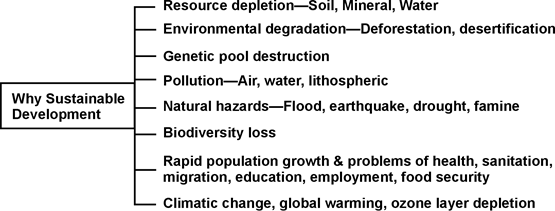
Answer:
Environment includes aboitic or physical (land, air & water) and biotic (plants and animals including humans) components of the life supporting layer. Environmental degradation refers to the deterioration in its physical components brought in by the biological processes, mainly by human activities to such an extent that it can not be set right by the self regulatory mechanism. In other words environmental degradation simply means overall Lowering of the environmental qualities because of adverse changes brought in by human activities in the basic structure of the components of the environments.
At present environmental degradation has emerged as a major global concern for human survival. In the opinion of the world commission on environment and development, the future is to face on ever increasing environmental decay, poverty, hardship which is more for the third world.
Men and his activities have resulted into environmental degradation to grave extent. Even physical environmental degradation is accelerated by human actions. Right from the dawn of human civilization, man has used nature not only for his existence and fulfillment of his necessities but also exploited it and to a certain extent destroyed the eco-system.
Thus several environmental problems have emerged due to technological scientific development on the one hand and over population Urbanisation and industrialisation on the other. Causes of environmental degradation can be analysed in the Following type of environmental problems:
Deforestation: Deforestation is one of the outcomes of various development activities having the character of extentional development. Forest clearing is made not only for village settlements but also for cultivation and pastures.
Following are the major causes of deforestation at global and regional level:
- Conversion of Forest land into agricultural land
- Shifting or Zhoming cultivation in hills and mountainous area
- Transformation of forests into pastures in Mediterranean and temperate areas for the expansion of dairy farming and cattle renching
- Forest Fires both natural and men made
- Lumbering for domestic and commercial purposes due to industrial expansion, urban growth and rapidly increasing human population
- Multipurpose river projects requiring large Forest areas to be submerged, e.g. Tehri dam project in India.
Consequences of Deforestion: Deforestation leads to increased run-off which together with absence of vegetal cover results into accelerated rate of soil-erosion there by increasing the sediment load in the rivers. This results into increase in the frequency and extent of Floods specially in the down-stream areas.
Deforestation also leads to reduced precipitation thereby causing the increase in the intensity of droughts. Deforestation has also led to the intensification of green house effect, these problems result into other problems such as decrease in agricultural production because of loss of fertile top soil, decrease in the supply of raw materials to the industries, decrease in fodder to animals etc.
Conservation Measures:
- A proper balance between forest cutting and plantation of trees
- Actual growth of trees to be properly supervised
- Strict prohibition of the cutting of trees for fuel
- Alternative for wood such as moulded plastic etc. be developed for furniture.
- Protection from forest fires
- National parks and sanctuaries be developed
- Emphasis on social forestry and farm forestry
- Long term master plan for forest conservation and development
- Participation of local communities be emphasized
Environmental Impact of Big Dams: The environment has been disturbed by those dams due to:
- Submergence of large areas under water
- destruction of vegetation and wild life
- region becomes vulnerable to earthquakes
- displacement and rehabilitation problems
Environmental Degradation Due to Mining: Digging of land in mining is carried out on a large scale. It causes following environmental problems.
- Destruction of land due to deep and surface mining
- Accumulation of waste material
- Destruction of natural vegetation and resultant ecological problem
- Pollution due to dust
- Expansion of barren land
These environmental problems can be checked through following conservational measures.
- Levelling of mining areas
- Planting trees in mining areas
- Implementing measures to check air and land pollutions
- Proper management and planning for regulated mining
Environmental problems caused by agriculture: Advance agricultural technology such as Hybreed seeds, increasing use of improved irrigation, chemical fertilizers, pesticides and farm mechanisation has led to:
- Salinization and alkalinization
- Soil erosion
- Loss in soil fertility
- Land and water pollution
- Reduction in bio-diversity
Such environmental problems can be checked by following measures:
- Increased use of green manures
- Rational use of irrigation facilities
- Minimizing the use of insecticides and pesticides
- Promoting bio-pesticides and insecticides
- Emphasising crop diversification, inter cropping etc.
- Drip irrigation and sprinkler irrigation be emphasised
Environmental Degradation Caused by Industrial Development: Rapid industrialization has resulted into following environmental problems:
- deforestation
- air, water and noise pollution
- threat of global warming
- ozone depletion through chloro-Flouro carbon
All these types of environmental degradation can be checked by resorting to large scale afforestation, implanting pollution control devices in the industries and automobiles, resorting to pollution-free sources of energy such as solar and wind energy etc. But all these measures can be successfully implemented only when we check the population growth in the world and exploit the resources to fulfill our needs, not the greeds.
Q7. Discuss the relevance of watershed as an ecosystem for the purpose of sustainable Development. (1999)
Answer:
Conservation of land, water, flora and fauna is of paramount importance for the ‘Sustainable Development’ of a nation/region. To this end, watershed, a geographically definable area constitute a basic and vital ecosystem involving intricate interaction between and among its biotic (man, animal, vegetation) components and abiotic components (soil, water, etc.). It is in this respect lies the importance of watershed to be chosen as a Geo-hydrologic ecological unit to plan and execute the development strategy of the region on a sustained basis.
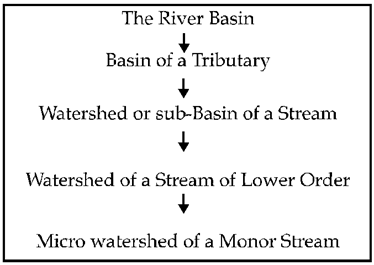
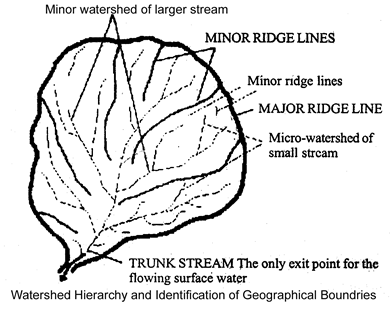
Watershed Concepts: Simply speaking, watershed is any special area from where water is collected and drained to a river i.e. the area from where water to a river comes from. The rainfall draining the uplands follow slopes to converge into small gullies and streams which in turn meet large tributaries and finally the main river course. Any of the constituents of a river- a tributary, a stream or a gully-has a defined catchment. This catchment area within the ridges and slopes or the drainage basin is defined as the watershed. It may vary from a few hectares to several hundred hectares.
Watershed is a smaller geographical unit of a river system. The river system and its total catchment have a hierarchial relationship with its smaller watershed units:
Watershed Management: Thus we see that land and water regime in a watershed are so directly and intricately linked with each other that it becomes a Geo-hydrological unit. A watershed is also a social unit where one or more communities depend on the natural resources of the watershed for their livelihoods.
Hence, it is better to treat a watershed as an ecosystem, a unified functional whole, for the better management and utilisation of its resources without disturbing the ecology of the area. Watershed Management is thus a holistic development concept that encompasses conservation, regeneration and judicious use of land, water, agriculture, forestry and all related matters in relation with the people who inhabit the area and their socio-cultural system.
The Need: Because of (rapid) population growth, cultivation of slopes and of even more marginal lands in increasing, a trend that only acclerates erosion. Forest and other sources of natural vegetation are being stripped for fuel and fodder. And lastly the most crucial aspect-the shortage of water is being felt almost everywhere, acquiring a global dimension, thanks to mismanagement and wasteful use of water resources.
The following flow diagram depicts a problem chain but in actual situation the problem chains are normally complex.
Development of watershed ecosystem offers an eco-friendly way that is effective in arresting degradation of natural resources and promoting economic development of the region involving direct participation of local community.
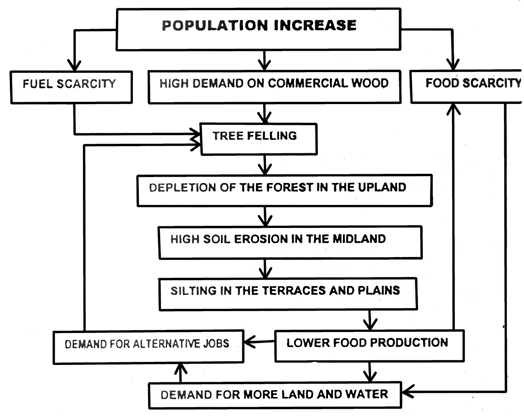
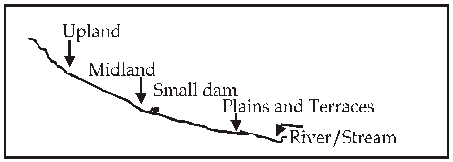
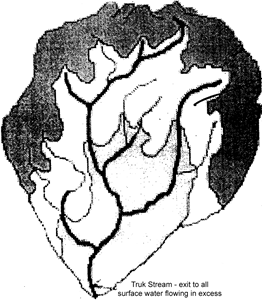
The Advantages: A watershed may constitute a simple or complex agro-ecologies. It is made up of a combination of upland-midland-lowland ecosystems. Each ecosystem in such a complex has its distinct function and land use capacity. Generally upland areas have the potential for horticulture and livestock development, midland represents dryland agroecology and lowland may strengthen their traditional agriculture through proper irrigation and land treatment practices. These are however few suggestions among limitless choices offered by watershed approach.
The main goal of watershed approach is to Catch The Water Where It Falls, otherwise it will run unused carrying away fertile soil simultaneously. Further it is possible to monitor and regulate the water resources more efficiently within the watershed ecosystem as the system in smaller.
In a watershed approach there is a scope to view the total water resource regime rather than targeting the plot of an individual farmer or for that matter a larger command area. Upland is thus an area for water harvesting, midland an area for small dams and springs development and low land for tapping ground water source.
The framework of watershed as an ecosystem provides the inter-ecological linkages
and hence a logical unit for the integration of the sustainable use of land and water. It helps augment soil and ground water resources. It joins the biophysical, social and economic inputs which when optimally managed, lead to diversified high agricultural production,control the environmental degradation and help in the recharging of ground water aquifers, thereby avoiding the ecological problems which our country have been facing after the successful introduction of Green Revolution. The approach of watershed ecosystem is the best tool to achieve an Evergreen Revolution (sustainable Agriculture)
Each watershed is presumably a unique ecosystem having its own set of ecological problems, quality of biotic and abiotic resources and prospects/opportunities, the proper assessment for which has to be made separately and the formulation and execution of the plan is to be done accordingly involving the direct participation of local community. This will lead to efficient and optimal utilisation of the resources of each watershed area on a sustainable basis.
Watershed ecosystem approach gives ample scope as well as warrants community participation and their development especially women empowerment through their participation. It can lead to benefitting use of their traditional wisdom especially the water harvesting techniques and creation of an effective mechanism for transparency, accountability, sharing of problems, benefits and recourses and Conflict Resolution-all these negate individual greed and are vital ingredients of ‘Sustainable Development’.
In case you still have your doubts, contact us on 9811333901.
For UPSC Prelims Resources, Click here
For Daily Updates and Study Material:
Join our Telegram Channel – Edukemy for IAS
- 1. Learn through Videos – here
- 2. Be Exam Ready by Practicing Daily MCQs – here
- 3. Daily Newsletter – Get all your Current Affairs Covered – here
- 4. Mains Answer Writing Practice – here

